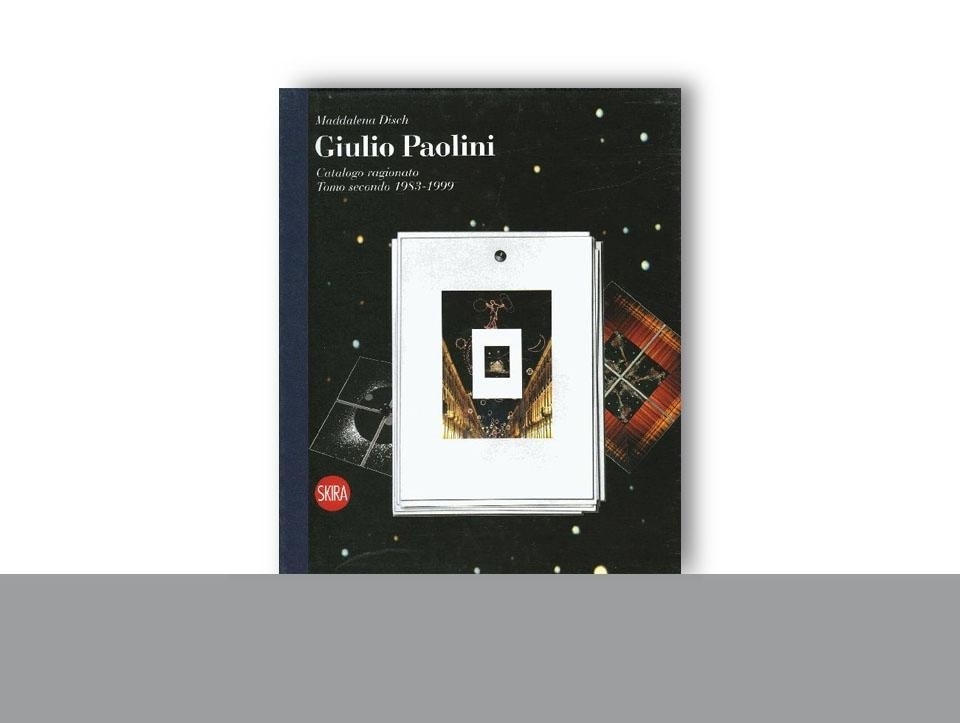Maddalena Disch, Skira, Ginevra-Milano 2008 (2 volumi, pp. 1.110, € 350,00)
This catalogue raisonné of the work of Giulio Paolini (Genoa, 1940) is published by Skira in collaboration with the Castello di Rivoli and the Fondazione Giulio e Anna Paolini. Avoiding the monotony of a dull list of facts, it completes research and studies started about nine years ago by the Turin museum. Hefty in size and containing an abundance of precise information, Giulio Paolini. Catalogo Ragionato 1960-1999 is the exhibition we will never see, with the voice of the artist himself to guide us. It comprises works that have been lost, destroyed, broken up and re-elaborated by the artist in new versions and designs. The catalogue's two volumes are dotted with comments by Paolini – most previously unpublished – inviting us to pursue as yet uncharted routes. One after another, the sequence of works clearly conveys the artist's train of thought and the constant references to other works in his forms and choices of titles.
The collection starts with Disegno geometrico (1960), Paolini's first work when he was aged just 20. Although the starting point, it has also been a constant in the research of this Turinese artist. It is the underlying theme of all his work and the spirit of this small white canvas seems to crop up on every page. Disegno geometrico is a picture that contains all possible pictures, a virtual catalogue of all images. Paolini geometrically squared this rectangle of white cloth, with two diagonal red lines crossing in the centre and the two orthogonal axes traced in black and intersected by the signs of the compass. Disegno geometrico is the preliminary basis for all other drawings and spatial constructions. The same geometric drawing constantly recurs in the catalogue, as in La Doublure (1972-73), 28 canvases reproducing fake perspective; as well as in Quadrato Immagine Uguale and also Un quadro (1970) – a set of 14 photographic canvases that hark back to the image of that first work, although each one is signed with the name of an imaginary author and has a new fictitious title (e.g. Estelle Masselin / Orto botanico and Arabella Florio Stewart / Interno a Miraneau).
As Paolini has said, "With Un quadro, I wanted to give my first work a certain universality, not only linking all my subsequent work back to that moment, but also giving it a sort of indisputable value as an image in itself." Although from the outset he participated in the exhibitions staged by the Arte Povera artists – including the first one at Galleria La Bertesca in Genoa, 1967 – Giulio Paolini's interest has always focused primarily on the artistic process and analysed art on the basis of art history. Containing citations and reproductions of works by the great past masters, from Lorenzo Lotto (Giovane che guarda Lorenzo Lotto, 1967) to Giorgio De Chirico and themes dear to classicism, Paolini's work constantly analyses the mechanisms of representation.
Although rigorously scientific, the book also serves up a wealth of brief but colourful stories and playful anecdotes, such as Lucio Fontana's purchase of Una poesia (1966) – one of Paolini's first works – after they met at the opening of a personal exhibition at the Galleria L'Ariete in Milan. In Platea (1977), the artist typed the word "platea" on 12 sheets of letter paper and then had them signed by four artists participating in the exhibition at the Teatro Godetti in Turin (Marco Bagnoli, Mario Merz, Remo Salvadori and himself), who adopted the name of another participant to mix up their handwriting and identities.
identities. If, as Paolini wrote, "an exhibition is, in turn, a picture […] it is our point of view, not the object (always the same or destined to become such) and the angle of our gaze (always different and unique) that define the exhibition space – who knows where", this catalogue does not merely present objects and works but also paints a new and different picture. The catalogue could perhaps have stolen its title from a Paolini work and been called Ipotesi per una mostra. Roberta Tenconi


